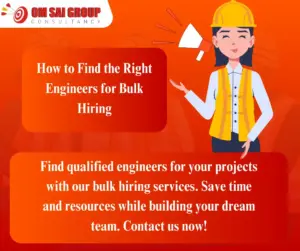Recruitment for engineering bulk hiring

Recruitment for engineering bulk hiring In the competitive world of technology, building a robust engineering team can make or break your company’s success. Recruitment the challenge multiplies when you’re tasked with hiring engineers in. Whether you’re a growing startup or a multinational corporation scaling a project, bulk hiring comes with its own set of obstacles: ensuring quality, meeting tight deadlines, managing costs, and maintaining a streamlined recruitment process. Recruitment for engineering bulk hiring In today’s dynamic market, where the demand for engineering talent often outstrips supply, companies frequently struggle with: Sourcing Qualified Candidates: Identifying candidates with the right mix of skills, experience, and cultural fit is a time-consuming process. Handling High Volumes: Screening hundreds or thousands of applications without compromising on quality is overwhelming. Reducing Time-to-Hire: Prolonged hiring timelines can lead to project delays and missed business opportunities. Avoiding Candidate Drop-Offs: Engineering talent is in demand, and high-caliber candidates often have multiple offers. These challenges are real, and without a structured approach, the recruitment process can become chaotic and expensive. Agitation: The Cost of Getting It Wrong Imagine this scenario: A tech company receives a large-scale project requiring 50 new engineers in three months. The HR team ramps up job postings, interviews, and assessments. But without a clear strategy, chaos ensues: Missed Deadlines: The project’s start date gets pushed back because the team is not fully staffed. Burnout: The recruitment team works overtime to compensate for inefficiencies, leading to mistakes and fatigue. Poor Quality Hires: In a rush to fill positions, standards are compromised, resulting in higher attrition rates. Increased Costs: Missed deadlines and low retention rates drive up the cost-per-hire, eating into budgets. According to a study by the Society for Human Resource Management (SHRM), the average cost-per-hire for technical roles is around $4,425. For bulk hiring, this number can skyrocket without an optimized process. Moreover, high attrition rates—which can be as high as 20% within the first six months—compound the issue. Companies like your own cannot afford such inefficiencies, especially when engineering talent is critical to innovation and staying ahead in the market. Solution: A Structured Approach to Bulk Hiring To tackle these challenges effectively, a structured recruitment strategy is essential. Here’s a roadmap based on proven practices and real-world case studies. 1. Sourcing Talent at Scale Leverage Multiple Channels Casting a wide net ensures you don’t miss out on quality candidates. Some effective channels include: University Partnerships: Collaborate with engineering colleges and universities to tap into fresh talent. Referral Programs: Encourage existing employees to refer candidates by offering attractive incentives. Online Platforms: Use job boards like Indeed, niche platforms like Stack Overflow, and LinkedIn for targeted sourcing. Case Study: Google’s University Outreach Google’s strategy involves partnering with top-tier universities worldwide. Through hackathons, internships, and workshops, they identify promising talent early. This proactive approach helps them build a pipeline of candidates ready for full-time roles. 2. Streamlining the Screening Process Use Technology to Automate Screening Screening hundreds of resumes manually is not sustainable. Applicant Tracking Systems (ATS) equipped with AI can: . Filter candidates based on keywords and skills. . Rank applicants by relevance to job requirements. . Reduce bias by standardizing the evaluation process. Structured Interviews Conduct structured interviews with pre-defined questions and evaluation criteria. This ensures consistency and fairness in assessing candidates. Case Study: Amazon’s Bar-Raiser Program Amazon’s bar-raiser program involves a designated panel member trained to uphold hiring standards. This individual focuses on ensuring that each hire meets or exceeds the company’s expectations, contributing to high-quality recruitment outcomes. 3. Reducing Time-to-Hire Pre-Screened Talent Pools Maintain a database of pre-screened candidates who can be approached for future roles. Regularly update this database with candidates from past interviews, networking events, and referrals. Concurrent Processes Implement parallel processes for assessments, interviews, and background checks to reduce delays. For example, while candidates are undergoing technical assessments, background checks can be initiated simultaneously. Case Study: Infosys’ Mass Recruitment Model Infosys developed a centralized recruitment model that reduced their time-to-hire by 25%. They implemented online coding tests for initial screening and conducted mass interviews during campus drives. 4. Enhancing Candidate Experience Clear Communication Keep candidates informed about their application status. Automated email updates and prompt responses to queries go a long way in building trust. Flexible Scheduling Offer flexible interview slots, including weekends or late evenings, to accommodate candidates’ schedules. Feedback Mechanisms Provide constructive feedback to all candidates, even those who don’t make it. This leaves a positive impression and opens the door for future opportunities. Case Study: Atlassian’s Candidate-First Approach Atlassian is known for its transparent and empathetic recruitment process. They use candidate feedback surveys to continuously improve their hiring practices, leading to higher offer acceptance rates. 5. Data-Driven Decision Making Metrics to Track Monitor key recruitment metrics to identify bottlenecks and optimize processes. Some important metrics include: . Time-to-Hire . Cost-per-Hire . Offer Acceptance Rate . Candidate Drop-Off Rate Regular Reviews Conduct periodic reviews of your recruitment strategy to adapt to changing market dynamics and business needs. Case Study: Microsoft’s Data-Driven Hiring Microsoft leverages data analytics to identify trends in candidate sourcing and performance. By analyzing historical data, they improved their screening processes and reduced hiring timelines by 30%. Conclusion: Turning Challenges into Opportunities Bulk hiring for engineering roles doesn’t have to be a daunting task. With the right strategy, tools, and mindset, companies can: . Source quality talent efficiently. . Streamline processes to save time and costs. . Enhance the candidate experience to improve retention. . Use data to drive continuous improvement. The key lies in planning, leveraging technology, and adopting best practices from industry leaders. By doing so, you can build an engineering team that not only meets today’s demands but also drives innovation for the future. Whether you’re scaling a team for a critical project or building a talent pipeline for long-term growth, a structured approach to recruitment is your best ally. Start implementing these strategies today and watch your hiring process transform from chaotic to seamless.
